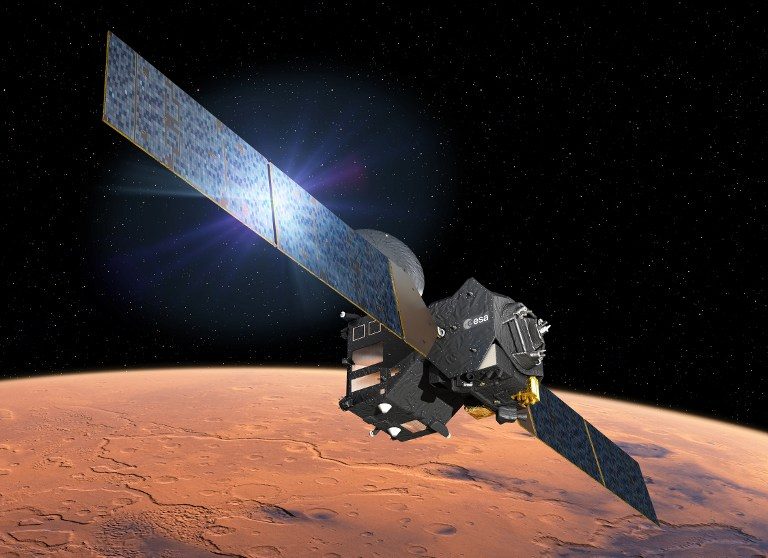SUMMARY
This is AI generated summarization, which may have errors. For context, always refer to the full article.

PARIS, France – A European lander started a 3-day, million-kilometer (621,000-mile) descent to Mars on Sunday, October 16, quitting its mothership to test technology for a daring mission to scout the Red Planet for signs of life.
Flight director Michel Denis confirmed the lander Schiaparelli had separated, to loud applause at mission control in Darmstadt, Germany some 175 million kilometers (109 miles) from where the manoeuver was executed.
Confirmation of the milestone separation was webcast live.
Thirteen years after its first, failed, attempt to place a rover on Mars, the high-stakes test is a key element in Europe’s latest bid to reach our neighboring planet’s hostile surface, this time working with Russia.
As planned, the 600-kilogram (1,300-pound), paddling pool-sized lander separated from an unmanned craft called the Trace Gas Orbiter (TGO) after a 7-month, 496-million-km trek from Earth.
Schiaparelli’s main goal is to test entry and landing gear and technology for a subsequent rover which will mark the second phase and highlight of the ExoMars mission.
After a two-year funding delay, the rover is due for launch in 2020, arriving about 6 months later to explore the Red Planet and drill into it, in search of extraterrestrial life – past or present.
While any life is unlikely to be found on the barren, radiation-blasted surface, scientists say traces of methane in Mars’ thin atmosphere may indicate something living underground – likely to be single-celled microbes, if that is the case.
Mars has become a graveyard for many a mission seeking to probe a planet that has captured the human imagination for millennia.
Since the 1960s, more than half of US, Russian, and European attempts to land and operate craft on the Martian surface have failed.
‘Complex mission’
The last time the European Space Agency (ESA) tried, the British-built Beagle 2 disappeared without a trace after separating from the Mars Express mothership in December 2003.
The mini-lab – a disc about the size of a dustbin lid – was finally spotted in January 2015 in a NASA image.
Getting a lander on Mars “is a complex mission,” said Thierry Blancquaert, Schiaparelli’s manager.
Craft must be built to survive a long trip from Earth, then a high-speed, ultra-hot journey through Mars’ tenuous, carbon dioxide-rich atmosphere.
They require protection against a heat of several thousand degrees Celsius (Fahrenheit) heat generated by atmospheric friction, extreme braking just above the surface, and a soft touchdown in terrain where any jagged rocks or craters could spell doom.
So far, only the United States has successfully operated rovers on Mars. (READ: US relies on industry help to make ‘giant leap’ to Mars)
After releasing its precious charge on Sunday, the TGO was programmed to change course to avoid crashing into Mars.
It will enter an eccentric orbit next Wednesday, October 19, just as Schiaparelli reaches the atmosphere at an altitude of some 121 km and a speed of nearly 21,000 kph.
The extreme ride through Mars’ atmosphere will take 6 minutes.
A discardable “aeroshell” will protect the lander against heat generated by atmospheric drag, while a supersonic parachute and 9 thrusters will brake it.
A crushable structure in the lander’s belly is meant to cushion the final impact.
With a 10-minute delay – the time it takes for a message to reach Earth –Schiaparelli will send data on temperature, humidity, density profile, and electrical properties – information seen as crucial to plan a safe landing for the much bigger and more expensive rover to follow.
Battery-driven and without solar panels, the lander should last for 2 or 3 days.
The TGO, meanwhile, will start a 12-month process of “aerobraking” – skimming the Martian atmosphere to bleed off energy – to change its egg-shaped orbit into a circular one.
Once this is achieved, in early 2018, it will begin its work of sniffing Mars’ atmosphere from an altitude of about 400 km for methane, which scientists believe may be secreted by microscopic organisms underground.
It could, however, also be the result of geological processes such as underground volcanoes. – Rappler.com
Add a comment
How does this make you feel?





There are no comments yet. Add your comment to start the conversation.